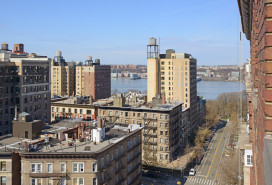Isn't there supposed to be a real bedroom window in my NYC apartment?
- NYC Housing Code requires bedroom windows to face outside, not a kitchen or dining room
- Renters should be wary of apartments that don’t meet NYC’s window requirements

A glass partition is no replacement for window that lets in light and fresh air.
iStock
I’m looking for a rental in New York City, and I’ve seen apartment listings with a bedroom window that faces the interior of the apartment, like the living room or kitchen. Is that legal?
In short: No. Under New York City’s Housing Maintenance Code, apartment bedrooms are required to have windows that open to the outside world.
Windows facing the hallway, kitchen, living room, or another indoor space do not meet the city’s requirements for access to light and outdoor air, according to Andrew Rudansky, press secretary at the NYC Department of Buildings. In other words: a landlord can’t simply slap a window on a home office and call it a bedroom.
"Interior windows cannot be used to meet the natural light requirements for habitable rooms in the city’s building code,” Rudansky says.
[Editor's Note: Realty Bites tackles your NYC rental questions. Have a query for our experts? Drop us an email. We respect all requests for anonymity.]
Let there be light
A legal bedroom in NYC must meet several requirements: it must be a minimum of 80 square feet in size, have two means of egress, and contain at least one operable window of at least 12 square feet, or a skylight in certain cases. There are additional safety requirements—including smoke and carbon monoxide detectors, light switches, and electrical outlets—and more rules on size that vary by the type of unit.
Your bedroom’s window needs to look out onto a street, yard, or balcony. Importantly, it needs to open to allow fresh air into your building.
“The purpose of the window requirement is to provide outside light, as well as outside air (via operable windows) unless outside air exchange is mechanically provided” by an HVAC system, for example, says Stephen Varone, founder and president of RAND Engineering & Architecture.
Plus, all the windows in the room need to add up to at least one-tenth of the space’s floor area, according to the Housing Maintenance Code. So if your room is 200 square feet in size, the window must have 20 square feet of glass.
Windows that open into an air shaft or lightwell—that space surrounded by a building’s walls—do count for these ventilation requirements, Varone says. In fact, that’s the main point of having a lightwell.
“The purpose of those wells is precisely that, to provide the code-required light and air,” Varone says.

Reporting illegal conversions
While window-shopping (wink wink) for an NYC apartment, make sure to check each bedroom for legal windows. You can usually view floor plans and images on online listing websites, and these issues are easy enough to spot on a tour. (Don’t be afraid to bring a measuring tape).
If you find an apartment you suspect has an illegal bedroom, you can report it to the DOB by calling 311, file a complaint online, or contact the DOB’s Quality of Life Unit, which inspects illegal conversions.






















